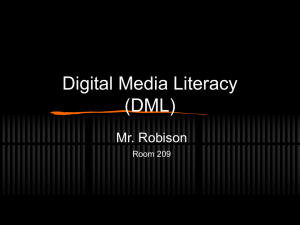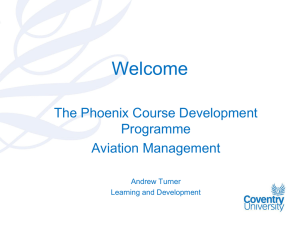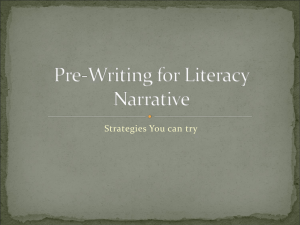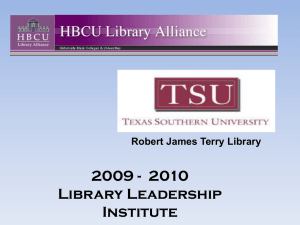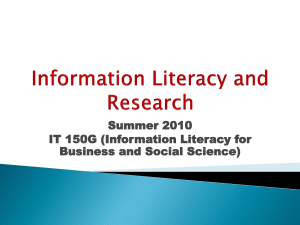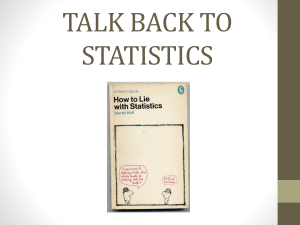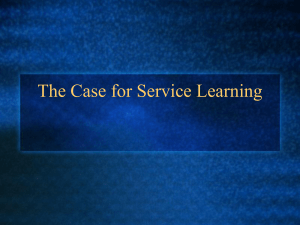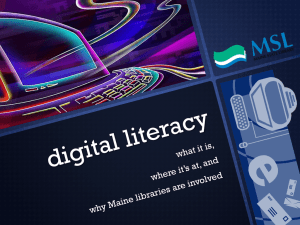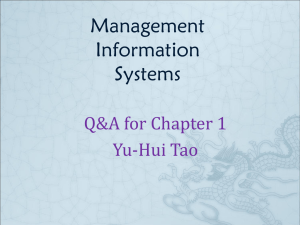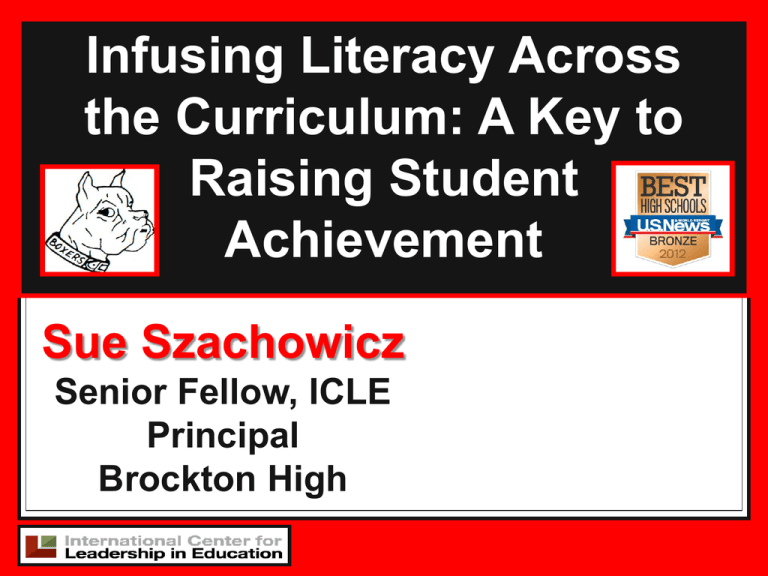
Infusing Literacy Across
the Curriculum: A Key to
Raising Student
Achievement
Sue Szachowicz
Senior Fellow, ICLE
Principal
Brockton High
Agenda for the session
WHO we are and what we faced
HOW we did this:
1.
Empowering a Team
2.
Focusing on Literacy
3.
Implementing with Fidelity
4.
Monitoring Like Crazy
Results: Changing the Culture
For What It’s Worth: Leadership advice
2
As we say in Boxer Country,
we are WICKED AWESOME!!!
Our Turn Around Story…
We did it our way!
Transforming a
Culture through
Literacy
A.K.A. - It’s
COOL to be
smart at
Brockton
High!!!
Our
“School of Champions”
Brockton High School
Brockton, Massachusetts
(For the entire PBS piece:
http://www.pbs.org/wnet/need-toknow/uncategorized/brockton-highproves-that-big-schools-can-begood-schools/6959/
http://www.pbs.org/wnet/need-toknow/uncategorized/brocktonhigh-proves-that-big-schools-canbe-good-schools/6959/
Who are We???
Our Demographics
•Comprehensive 9 – 12
•Enrollment: 4,181
•Poverty Level: 75%
•Minority population: 73%
•50 different languages
•50% speak another
language in the home
•Approximately 12% in
Transitional Bilingual Ed.
•Approximately 11% receive
Special Education Services
Meet our Students
57% Black - includes African
American, Cape Verdean,
Haitian, Jamaican, and others
26% White
14% Hispanic
2.5% Asian
.5% Native
American
\The Problem:
(actually we had many…)
Mass. implemented a high stakes test (MCAS)
Three-quarters of our students would not be
earning a diploma
Culture of low expectations – “Students have a
right to fail”
Negative image in our city, in the state
Yet we were living in DENIAL!!!!
Who is responsible???? We had silos (My kids,
your kids, not OUR kids)
Success by chance – depended on who your
teacher was – are you lucky???
State Mandates…We faced:
MCAS 1998
Failure
ELA – 44%
(Sped – 78%)
MATH – 75%
(Sped – 98%)
MCAS 1998
Advanced+Proficient
ELA – 22%
MATH – 7%
Remember, they MUST pass
to graduate – NO exceptions!
MCAS??? So
you think it’s
easy???
ELA MCAS SELECTIONS:
(and remember, they are sophomores!)
Burial at Thebes from Sophocles’ Antigone
Shakespearean Sonnet # 73
Heart of Darkness by Joseph Conrad
Love in the Time of Cholera by Gabriel
Garcia Marquez (3 page excerpt)
Making Humus by Composting by Liz Ball
Proof (four page play excerpt by
David Auburn)
SAMPLE MCAS MATH QUESTION: Jason launched a model rocket
from the ground. The formula below can be used to determine the
height of the rocket above the ground at any time during the
rocket’s flight.
h = 16t(7 – t)
In the formula, h and t are defined as follows:
• t = the time, in seconds, that has elapsed since the rocket was
launched
• h = the height, in feet, of the rocket above the ground at time t
Use the formula to answer the following questions.
a. What was the height, in feet, of the rocket 1 second after it
was launched? Show your work.
b. What was the height, in feet, of the rocket 6 seconds after it
was launched? Show your work.
c. The value of h was 0 when the rocket hit the ground. How
many seconds after the rocket was launched did it hit the
ground? Show your work.
d. How many seconds after the rocket was launched was the
height of the rocket 160 feet? Show your work.
12
SAMPLE MCAS BIOLOGY QUESTION:
Corn snakes show variety in their skin color pattern. While the complete
genetics of corn snake color are complex, the most common colors on
normal corn snakes—red and black—are each coded by one gene.
For the red gene, the allele for the presence of red pigment (R) is dominant and the
allele for the absence of red pigment (r) is recessive. Likewise, for the black gene, the
allele for the presence of black pigment (B) is dominant and the allele for the absence
of black pigment (b) is recessive.
a. Draw the Punnett square for the cross of a snake that is homozygous dominant for
the red color with a snake that is heterozygous for the red color. What percentage
of the offspring is expected to have red pigment in their skin?
b. Draw the Punnett square for the cross of two snakes that are heterozygous for the
black color. What percentage of the offspring are expected to have black pigment
in their skin?
c. The parent snakes in part (b) that are heterozygous for black color are both
homozygous recessive for the red gene. Each parent has genotype rr for the red
gene. Based on this information, what percentage of their offspring are expected
to lack both the red and black pigments in their skin? Explain your reasoning.
Can you believe this???
But even worse… We faced a
flawed belief system:
“Students have a
right to fail.”
Former BHS Principal
Success at Brockton High then ???
That’s where we were…
Here’s a preview of
where we are now…
Then, at the end some
WICKED AWESOME
stuff!…
THEN
NOW
MCAS 1998
MCAS 2012
Advanced+Proficient
Advanced+Proficient
ELA – 22 %
MATH – 7 %
ELA –
83.3%
MATH –70.3
%
THEN
NOW
MCAS 1998
MCAS 2012
Failure
ELA – 44%
Failure
MATH – 75%
ELA –
1.9%
MATH – 8.7%
It’s cool and fun to be
smart
1998
859 STUDENTS
(4400 students)
19%
Honor Roll
2012
Statistics 1561 STUDENTS
(
(4100 students)
38%
Turnaround at Brockton High
Emphasis on literacy brings big MCAS improvement
Principal Susan Szachowicz, shown chatting at lunch with Yiriam Lopez,
is in many ways the school’s biggest cheerleader. (Essdras M Suarez/ Globe Staff)
By James Vaznis Globe Staff / October 12, 2009
BROCKTON - Brockton High School has every excuse for failure, serving a city
plagued by crime, poverty, housing foreclosures, and homelessness.
Almost two-thirds of the students qualify for free or reduced-price lunches, and 14
percent are learning to speak English. More than two-thirds are African-American
or Latino - groups that have lagged behind their peers across the state on
standardized tests.
But Brockton High, by far the state’s largest public high school with 4,200
students, has found a success in recent years that has eluded many of the state’s
urban schools: MCAS scores are soaring, earning the school state recognition as a
symbol of urban hope.
So, that’s who we are…
What did we do?
Brockton and ICLE philosophy
Rigor
Relevance
Relationships
ALL students-and
ALL means ALL!!!
Our Literacy Initiative reflects BOTH
RIGOR and RELEVANCE
Literacy for ALL – NO
exceptions!!!
Schoolwide Literacy
Skills (we all do it
THIS way!)
Schoolwide rubrics for
assessment
Review of student work
The content provides
the CONTEXT for
teaching the
Literacy Skills
The electives engage
the students and
provide the real life
application
So, what did we do???
Our turnaround: 4 Steps
1.
2.
3.
4.
Empowered a Team
Focused on Literacy –
Literacy for ALL, no
exceptions- all means all
Implemented with fidelity
and according to a plan
Monitored like crazy!
Step ONE: Empowering a
Leadership Team
Restructuring Committee – our “think tank”
Every
department represented with a
mix of teachers and administrators
Balance of new teachers and
veterans, new voices
and voices of experience
Challenge for Change
funding
We looked at the data
And, our first plan:
Let’s figure out the test
The result of that:
The Great
Shakespearean Fiasco
Questions about our
instructional practices
WHAT are we teaching?
HOW are we teaching it?
HOW do we know our
students are learning it?
Questions about
making change
WHAT can we control, what
can’t we control?
WHAT resources do we
have that we can use more
effectively?
And our most important question:
Is this the BEST we can be?
After our Shakespearean
disaster, a better approach:
I
We asked what should
we be teaching???
Our solution:
LITERACY!!!
And it helped us become one of
the 100 Best!
INSERT VIDEO from America’s
Promise 100 Best
Brockton High’s turnaround
FOUR STEPS:
1.
Empowered a team
2.
Focused on Literacy
for ALL, NO
exceptions
3.
Implemented with fidelity and according to a
plan
Monitored like crazy!
4.
Step TWO: Focused on
Literacy for ALL
The “WHAT”:
LITERACY for ALL:
Reading, Writing,
Speaking, Reasoning
How did we determine our focus?
Literacy Skills Drafted:
LITERACY CHART: WRITING
SCIENCE
MATH
ENGLISH
to
to
to
to
to
to
to
to
to
WRITING
SOCIAL
SCIENCE
ELECTIVE
take notes
explain one’s thinking
argue a thesis and support one’s thinking
compare and contrast
write an open response
describe an experiment, report one’s findings, and report one’s conclusion
generate a response to what one has read, viewed, or heard
convey one’s thinking in complete sentences
develop an expository essay with a formal structure
c Brockton High School, 2002
34
L IT E R A C Y C H A R T : W RIT IN G
LITERACY CHART: READING
MATH
ENGLISH
SCIENCE
SC IE N C E
SOCIAL
SCIENCE
M AT H
ELECTIVE
READING
for content ( both literal and inferential )
to apply pre-reading, during reading and post-reading strategies to all
reading assignments, including determining purpose and pre-learning
vocabulary
to research a topic
to gather information
to comprehend an argument
to determine the main idea of a passage
to understand a concept and construct meaning
to expand one’s experiences
LITERACY CHART: SPEAKING
ENGLISH
SCIENCE
to
to
to
to
to
to
to
to
to
take notes
explain one’s thinking
argue a thesis and support one’s thinking
com pare and contrast
w rite an open response
describe an experim ent, repo rt one’s findings, and report one’s conclu sion
generate a response to w hat one has read, view ed, or heard
convey one’s thinking in com plete sentences
develop an expository essay w ith a form a l structure
LITERACY CHART: REASONING
SPEAKING
SCIENCE
SOCIAL
SCIENCE
MATH
ELECTIVE
to convey one’s thinking in complete sentences
to interpret a passage orally
to debate an issue
to participate in class discussion or a public forum
to make an oral presentation to one’s class, one’s peers, one’s community
to present one’s portfolio
to respond to what one has read, viewed, or heard
to communicate in a manner that allows one to be both heard and
understood
c Brockton High School, 2002
E L E C T I VE
W R IT IN G
c B rockton H igh S ch ool, 2002
c Brockton High School, 2002
MATH
E N G L I SH
SO C I AL
SC IE N C E
ENGLISH
REASONING
SOCIAL
SCIENCE
ELECTIVE
to create, interpret and explain a table, chart or graph
to compute, interpret and explain numbers
to read, break down, and solve a word problem
to interpret and present statistics that support an argument or hypothesis
to identify a pattern, explain a pattern, and/or make a prediction based on a
pattern
to detect the fallacy in an argument or a proof
to explain the logic of an argument or solution
to use analogies and/or evidence to support one’s thinking
to explain and/or interpret relationships of space and time
c Brockton High School, 2002
ALWAYS REMEMBER
I
The PROCESS of involving
everyone was critical to our
success. We did not have
buy-in, but we did have our
faculty engaged in the
process.
ENGAGING THE FACULTY:
Interdisciplinary discussion groups on the drafts
using 3 guiding questions:
1. In each of the four areas of Reading, Writing,
Speaking and Reasoning, have we
included what is required for students to be
successful in your class/your content
area? (What did we miss???)
2. Is the skill stated clearly so that all teachers
and students can understand it?
3. Is the skill applicable to ALL content areas?
“Lessons Learned the Hard Way”
Tip:
Put all your negative
folks together in a
group so they don’t
spread their toxic
fumes.
L IT E R A C Y C H A R T : W RIT IN G
LITERACY CHART: READING
MATH
ENGLISH
SCIENCE
SC IE N C E
SOCIAL
SCIENCE
M AT H
ELECTIVE
READING
for content ( both literal and inferential )
to apply pre-reading, during reading and post-reading strategies to all
reading assignments, including determining purpose and pre-learning
vocabulary
to research a topic
to gather information
to comprehend an argument
to determine the main idea of a passage
to understand a concept and construct meaning
to expand one’s experiences
LITERACY CHART: SPEAKING
ENGLISH
SCIENCE
to
to
to
to
to
to
to
to
to
take notes
explain one’s thinking
argue a thesis and support one’s thinking
com pare and contrast
w rite an open response
describe an experim ent, repo rt one’s findings, and report one’s conclu sion
generate a response to w hat one has read, view ed, or heard
convey one’s thinking in com plete sentences
develop an expository essay w ith a form a l structure
LITERACY CHART: REASONING
SPEAKING
SCIENCE
SOCIAL
SCIENCE
MATH
ELECTIVE
to convey one’s thinking in complete sentences
to interpret a passage orally
to debate an issue
to participate in class discussion or a public forum
to make an oral presentation to one’s class, one’s peers, one’s community
to present one’s portfolio
to respond to what one has read, viewed, or heard
to communicate in a manner that allows one to be both heard and
understood
c Brockton High School, 2002
E L E C T I VE
W R IT IN G
c B rockton H igh S ch ool, 2002
c Brockton High School, 2002
MATH
E N G L I SH
SO C I AL
SC IE N C E
ENGLISH
REASONING
SOCIAL
SCIENCE
ELECTIVE
to create, interpret and explain a table, chart or graph
to compute, interpret and explain numbers
to read, break down, and solve a word problem
to interpret and present statistics that support an argument or hypothesis
to identify a pattern, explain a pattern, and/or make a prediction based on a
pattern
to detect the fallacy in an argument or a proof
to explain the logic of an argument or solution
to use analogies and/or evidence to support one’s thinking
to explain and/or interpret relationships of space and time
c Brockton High School, 2002
So now what…
We had cool looking charts on
the walls… SO WHAT…
The KEY to our implementation
is HOW we trained teachers
to teach these Literacy skills
to our students.
It’s All About Instruction
“…the single greatest determinant of
learning is not socioeconomic factors
or funding levels. It is instruction.”
Results Now by Mike Schmoker
“The single most influential component of
an effective school is the individual
teachers within the school.” Robert Marzano
41
Says Mike Schmoker in
Results Now
It’s about teaching,
stupid…
42
Step THREE: Implemented
with fidelity and a plan
Faculty Meetings became
Literacy Workshops
KEY = Adult Learning
Teachers teaching
teachers – GOOD stuff!
FOCUS, FOCUS,
FOCUS
We started with
writing!
Writing is
thinking
L IT E R A C Y C H A R T : W R IT IN G
SC IE N C E
M ATH
E N G L I SH
to
to
to
to
to
to
to
to
to
W R IT IN G
SO C I A L
SC IE N C E
ELEC TIVE
take n otes
exp lain on e’s th in kin g
argu e a th esis an d su p p ort on e’s thin kin g
com p are an d con trast
w rite an op en resp on se
d escrib e an exp e rim en t, rep o rt on e’s fin d in gs, an d rep ort on e’s con clu sion
gen erate a resp on se to w h at on e h as read , view ed , or h eard
con vey on e’s th in kin g in com p lete sen ten ces
d evelop an exp ository essay w ith a form a l stru ctu re
c B rockton H igh S ch ool, 2002
BUT….
Don’t think for a moment that
everyone was happy…
BUT, if we waited for buy-in,
we’d still be waiting.
SO, what did we do?? Meet
Sharon and Penny
INSERT PBS NEED TO KNOW
VIDEO ON PENNY AND SHARON
http://www.pbs.org/wnet/need-toknow/uncategorized/brocktonhigh-proves-that-big-schools-canbe-good-schools/6959/
Brockton High’s turnaround
FOUR STEPS:
1.
2.
Empowered a team
Focused on Literacy – Literacy for ALL, NO
exceptions
3.
Implemented with
fidelity and according
to a plan
4.
Monitored like crazy!
Restructuring Committee
process:
1.
2.
3.
4.
Targets the Literacy Skill
Smaller subgroup drafts training
script, brings draft to the full
committee, revisions made
Roll out to faculty – step one:
Interdisciplinary group training
Follow up in depts – how to
implement in content area
Our First Training: Open Response
OPEN RESPONSE STEPS TO FOLLOW
1. READ QUESTION CAREFULLY.
2. CIRCLE OR UNDERLINE KEY WORDS.
3. RESTATE QUESTION AS THESIS (LEAVE BLANKS)
4. READ PASSAGE CAREFULLY.
5. TAKE NOTES THAT RESPOND TO THE QUESTION.
BRAINSTORM & MAP OUT YOUR ANSWER.
6. COMPLETE YOUR THESIS.
7. WRITE YOUR RESPONSE CAREFULLY, USING
YOUR MAP AS A GUIDE.
8. STATEGICALLY REPEAT KEY WORDS FROM
THESIS IN YOUR BODY AND IN YOUR END
SENTENCE.
9. PARAGRAPH YOUR RESPONSE.
10. REREAD AND EDIT YOUR RESPONSE.
Changes in ELA Results Year One
of School Wide Open Response
Changes in Math Results Year One
of School Wide Open Response
So then what…
Follow up the Interdisciplinary
Training.
Next step – HOW to bring this
into the classroom
Lessons developed
Implemented according to a
calendar
Step THREE: Implemented
with fidelity and a plan
We didn’t leave it to chance.
(Success by design, not by
chance!)
The implementation was
according to a specific
timeline…
As a follow up to this activity, I am requiring Department Heads to
collect from each teacher at least one student sample from each of the
The Open Response calendar of
teachers’ classes. The student samples should include:
implementation
is as follows:
Student
Name
Name
NovTeacher
2-6:
Social
Science,
Social
Sci
Biling.
Date
NovCourse
30-Dec
JROTC
Name4:
and Wellness,
Level
DecPeriod
14-18: Science, Science Bilingual
A copy of the reading selection and question
JanEvidence
11-15:of the
Business,
Tech,
& Career Ed.
student’s active
reading
pre-writing work that the student has done, e.g. webs
JanAll
25-29:
Math, Math Bilingual
A copy of the written open response
FebThe
22-26:
Foreign
Lang,
Special
Ed
new scoring
rubric and
completed
assessment
Mar. 7-11:
English, ESL, Guidance
After you have collected the samples from each teacher and have had
20-24
Family
&Cons.
Sci,
ProjGrads
theMar
opportunity
to review
them for
quality and
completeness,
please
send them to me in a department folder with a checklist of your
Apr 5-9:
Music, Art
teachers. Again, please be sure that your teachers clearly label their
student samples.
55
From Talent is Overrated
by Geoff Colvin
The factor that seems to explain the
most about great performance is
something the researchers call
deliberate practice… Deliberate
practice is hard. It hurts. But it works.
More of it equals better performance.
Tons of it equals great performance.
How did we incorporate these
Literacy Skills in every discipline?
Emily Dickinson is a poet who often wrote about her own
emotional struggles. In two poems “Heart, We Will
Forget Him” and “Knows How to Forget” she writes
about how difficult it is to forget. Please read the two
poems and the brief biography and answer the following
three questions:
1. What were some of experiences in her life that
influenced her writing?
2. What do the two poems have in common?
3. How are the two poems different?
Please use one quote from the poems or biography in
each paragraph.
How did we incorporate these
Literacy Skills in every discipline?
Even in our discipline policies
and procedures we
incorporate our Literacy
Initiative… remember,
WRITING IS THINKING!
Excerpt from
reading/
writing
assignment
Sagging
Pants
Issue
Please inform the parents and students that I am a retired
police officer and African American, and I am raising young
teenage boys. Two of my boys are African American and
the other is Black and Latino. As a parent and a former law
enforcement officer and Gubernatorial appointed official in
the criminal justice arena, I get it and I sympathize and
empathize with what is happening to our young boys.
For all of you that think it is nice to walk with your pants
below your butt, read the following explanation:
This trend was born in the United States’ jails where
prisoners who were willing to have sex with other prisoners
needed to invent a signal that would go unnoticed by the
prison guards so they wouldn't suffer consequences. So by
partially showing their butt, they showed that they were
available to be penetrated by other inmates. So, since the
"pants exposing a man's backside" practice originated in
prison, I wonder, do the young men who emulate the
inmates know that along with signaling to other men that
their hindquarters is "open for entertaining", also know that
they are displaying that they desire the life of a
subjugation?
Our
Classroom
Incident
form
requires
students to
write when
they come
into the
office
Brockton High’s turnaround
FOUR STEPS:
1.
2.
3.
4.
Empowered a team
Focused on Literacy – Literacy for ALL,
NO exceptions
Implemented with fidelity and
according to a plan
Monitored like crazy!
(what gets monitored is what gets done!)
Monitoring both the student
work and the implementation
What gets monitored is what
gets done!
Monitoring the work
of the students AND
Monitoring the
implementation by the faculty
How do we know the
students
are learning it?
Monitoring the
implementation
What gets monitored is
what gets done!
Implementation set by
calendar
Admin team present in
classrooms observing the
literacy lesson
Follow up walkthroughs
Frequent feedback provided
Focused collegial conversations
around examining student work
Implemented a review protocol:
• What was the grading criteria?
• Were the standards high enough (what is good enough?)
• In what ways does this work meet or fail to meet the set
standard?
• What do the student responses indicate about the
effectiveness of the assignment?
• How might the assignment be improved?
• Did you find evidence of growth over time?
• What did you notice about consistency across classes,
departments? Other “what do you notice” observations?
Step FOUR: Monitored like
crazy!!!
What Gets Monitored Is What Gets Done!
Faculty: Assessment based on rubrics
Department Heads: Collect, assess,
dialogue, and assist teacher
Associate Principal: Collect, assess,
dialogue, make necessary adjustments
Listen to Prof. Ron Ferguson, Director,
Achievement Gap Institute, Harvard
INSERT PBS NEED TO KNOW
VIDEO on Ferguson
http://www.pbs.org/wnet/need-toknow/uncategorized/brockton-highproves-that-big-schools-can-begood-schools/6959/
LITERACY CHART: READING
MATH
ENGLISH
SCIENCE
READING
SOCIAL
SCIENCE
ELECTIVE
for content ( both literal and inferential )
to apply pre-reading, during reading and post-reading strategies to all
reading assignments, including determining purpose and pre-learning
vocabulary
to research a topic
to gather information
to comprehend an argument
to determine the main idea of a passage
to understand a concept and construct meaning
to expand one’s experiences
c Brockton High School, 2002
70
The key: Teaching
everyone HOW
Reading Workshop on TOVANI’S
I Read It But I Don’t Get It
and
Do I Really Have to
Teach Reading?
Active Reading Strategies
1. Read the question.
2. a. Circle key direction verbs.
For example – write, draw,
explain, compare, show, copy
b. Underline important information.
Often there is information in a
question that is irrelevant to
finding the answer.
3. In your own words, write what the
question is asking you to do.
4. Develop your plan/Answer the
question.
INSERT SAMPLE
STUDENT PAPER
LITERACY CHART: SPEAKING
MATH
ENGLISH
SCIENCE
SPEAKING
SOCIAL
SCIENCE
ELECTIVE
to convey one’s thinking in complete sentences
to interpret a passage orally
to debate an issue
to participate in class discussion or a public forum
to make an oral presentation to one’s class, one’s peers, one’s community
to present one’s portfolio
to respond to what one has read, viewed, or heard
to communicate in a manner that allows one to be both heard and
understood
ORAL PRESENTATION RUBRIC
Presenter:______________________________ Evaluator:______________________________
Oral
Presentation
Rubric
Literacy in Speaking:
to make an oral presentation to one’s class
to communicate in a manner that allows one to be both heard and understood
to convey one’s thinking in complete sentences
SPEAKING SKILLS
All elements
present
Most elements
present
Some elements
present
No elements
present
Delivery (Presenter doesn’t rush, shows
4
3
2
1
4
3
2
1
4
3
2
1
4
3
2
1
CONTENT
All elements
present
Most elements
present
Some elements
present
No elements
present
Introduction
4
3
2
1
a. Presentation includes all elements
previously determined by the teacher.
4
3
2
1
b. Presentation is clearly organized.
(Material is logically sequenced, related
to thesis, and not repetitive.)
4
3
2
1
c. Presentation shows full grasp and
understanding of the material.
4
3
2
1
a. Presentation highlights key ideas and
concludes with a strong final statement.
4
3
2
1
b. Presenter fields questions easily.
4
3
2
1
enthusiasm, avoids likes, ums, kind ofs, you
knows, etc. Uses complete sentences.)
Eye Contact (Presenter keeps head up,
does not read, and speaks to whole audience.)
Posture (Presenter stands up straight, faces
audience, and doesn’t fidget.)
Volume (Presenter can be easily heard by
all. No gum, etc.
Presentation begins with a clear focus/thesis.
Topic Development
Conclusion
TOTAL NUMBER OF POINTS:
35 – 40 = A
29 – 34 = B
23 – 28 = C
* Evaluator: Place comments beside each descriptor
17 – 22 = D
10 – 16 = F
L IT E R A C Y C H A R T : R E A SO N IN G
SC IE N C E
M ATH
E N G L I SH
R E A S O N IN G
SO C I A L
SC IE N C E
ELEC TIVE
to create, in terp ret an d exp lain a tab le, ch art or grap h
to com p u te, in terp ret an d exp lain n u m b ers
to read , b reak d ow n , an d solve a w ord p rob lem
to interp ret an d p resen t statistics th at su p p ort an argu m en t or h yp oth esis
to id entify a p attern , exp lain a p attern , an d /or m ak e a p red iction b ased on a
p attern
to d etect th e fallacy in an argu m en t or a p roo f
to exp lain th e logic of an argu m en t or so lu tion
to u se an alogies an d /or evid en ce to s u p p ort on e’s th in kin g
to exp lain an d /or in terp ret relation sh ip s of sp ace an d tim e
c B rockton H igh S ch ool, 2002
Literacy Training
for the faculty
Key = Adult Learning – Teachers
teaching teachers = SUCCESS!
BHS Literacy Workshop
April 28th 2011
Reading Visuals
78
Agenda
• Opener – Think and Pair.
• Reading Visuals presentation
• Practice using Reading Visuals 5 step
process
• Discussion and feedback
• Closer – Think, Plan, Share
79
What We Know
There are several types
of visuals used in all
classes and on both
the science and math
MCAS exams.
Students often attempt
to answer the
questions without
fully understanding
the content of the
visual.
80
Reading Visuals
The process of reading a visual
begins with understanding and
analyzing the given
information BEFORE
attempting to answer the
questions or solve a problem.
81
Reading Visuals
• Introductory
Information
•Title
•Key or
Legend
•Labels and
parenthetical
information
•Correlations
82
5 Steps for Reading Visuals
1. Identify the type of visual
2. Determine the topic of the visual
3. Examine the given information from the
visual (including all introductory text)
4. Develop predictions, deductions, inferences
or conclusions about the visual
5. Analyze the questions and determine the
information needed from the visual
83
5 Steps for Reading Visuals
Practice Steps 1-4 using the math data below.
84
Your Turn
5 Steps for Reading Visuals
1. Identify the type of visual
2. Determine the topic of the visual
3. Examine the given information from the
visual (including all introductory text)
4. Develop predictions, deductions, inferences
or conclusions about the visual
5. Analyze the questions and determine the
information needed from the visual
85
86
Looking Ahead
• The May 5th faculty meeting will be in
department and will focus on using the Reading
Visuals Steps with content specific graphs, tables
and diagrams
• Over the next few weeks we will all use visuals in
classes to help students develop stronger reading
and reasoning skills
• Our goal is to improve student achievement
across the board and see gains in the science and
math MCAS exam scores
87
Closer
Think – Plan – Share
Identify a visual or type of visual you will
use to teach students the Reading
Visuals Steps.
Describe how the steps for reading
visuals will help your students improve
their reading and reasoning skills.
88
We have the power to improve
student achievement!
Thank you
89
How do we ensure our message is
consistent?
The Script
Slide #
1
Power Point Slide
Script
Opener
AS YOU ENTER SIT AT THE TABLE WITH THE COLOR THAT
MATCHES YOUR STICKY NOTE
Everybody Writes:
Make a prediction about the connections
between Reading Visuals and Active Reading of
directions, prompts or questions.
1
As faculty enters the room,
instruct them to sit in their
color group and begin the
Everybody Writes (EW). This
is an individual opening
activity that will not be
discussed.
Time
Find
place 1
min
EW – 2
minutes
90
Slide #
2
Power Point Slide
Time
Script
Reading Visuals and Active
Reading Literacy Objectives
We will REASON to make predictions
and to explain and interpret relationships
We will READ to apply pre-reading
strategies
We will WRITE to generate a response and
SPEAK to convey our thinking
2
1
Today we are focusing on Reading
Visuals and Active Reading strategies. min
Our objective is to combine the
strategies to create a process that will
help students:
Reason to make predictions
Explain and interpret relationships
Apply pre-reading strategies
Generate a written a response and
Convey thinking through speaking
91
How did we incorporate these
Literacy Skills in every discipline?
The Reasoning Skills Chart develops
the higher level math skills.
Two examples of a
Reading Visuals lesson
from a Wellness class
Topic: Bullying
How does this fit with
the Common Core?
Key points in ELA and Content Area Literacy: Look at the Strands:
Reading
Writing
Speaking/Listening Language
Look at the Anchor Standards under each Strand:
-Key Ideas
and Details
-Craft and
Structure
-Integration
of knowledge,
and Ideas
-Range of
Reading,
Level of Text
Complexity
-Text Types
-Production
and
Distribution
of Writing
-Research to
Build and
Present
Knowledge
-Range of
Writing
- Comprehension
and Collaboration
- Presentation of
Knowledge and
Ideas
What do our
students need to
be able to do
based on these?
- Conventions
of Standard
English
- Knowledge of
Language
- Vocabulary
Acquisition
and Use
What should you do?
Here’s what we’re doing:
RE: The Common Core: Get to know the
Anchor Standards. What skills/tasks
do the students need to demonstrate?
Our questions:
1. What are we doing well?
2. What are we doing somewhat?
3. Where are our gaps?
What should you do?
Here’s what we’re doing:
RE: Next Generation Assessments
Look at the samples that our out there.
What are the students being asked to do.
Share them with the faculty.
Our questions:
1. How do these reflect our Literacy
Initiative?
2. Are we prepared to teach these?
3. How do we build our instructional
expertise on these types of assessments?
Look at PARCC sample
questions in ELA:
VOCABULARY IN CONTEXT!
Look at PARCC sample questions in math:
READING AND ANALYZING VISUALS!
We can’t forget
The Third “R”
As success grew, so
did relationships
Relationships
“People will forget what you
said, people will forget what
you did, but people will
never forget how you made
them feel.”
Maya Angelou
Honor Roll Assemblies – Celebrate and Laugh!
103
College for ALL:
Changing students’ beliefs:
Class of 2012 – 90%
heading to college!
104
Boxer Buddies
A lasting friendship
We have built a lasting relationship
which we will forever treasure in our
hearts
And the MOST unbelievable moment for four of
our Brockton Boxer Buddies
But not just ANY Pledge of Allegiance…
These are
our hands
RECAP: Our 4 Steps
When all 3 R’s come together
1. Empowering a team
2. Focusing on literacy:
Literacy for ALL – NO exceptions
3. Implementing with fidelity and
according to a plan
4. Monitoring, monitoring, monitoring
The Result = Changing the Culture
It’s ALL about literacy
DOES IT WORK???
Listen to what the students
think of our Literacy
Initiative… meet Fabieny
DePina on PBS Need to
Know
INSERT VIDEO WITH
FABIENY
INSERT
PBS NEED TOKNOW
VIDEOhttp://www.pbs.org/wnet/ne
ed-toknow/uncategorized/brocktonhigh-proves-that-big-schools-canbe-good-schools/6959/
TEACHER LEADERSHIP
Some Schools Stand Out
Comparisons of
Complacent HS and Brockton HS
Ronald F. Ferguson, PhD
Tripod Project for School Improvement (www.tripodproject.org) and
Achievement Gap Initiative at Harvard University
(www.agi.harvard.edu)
•The Achievement Gap Initiative At Harvard University
Toward Excellence with Equity
Conference Report by Ronald F. Ferguson, Faculty Director
“The main lesson was that
student achievement rose
when leadership teams
focused thoughtfully and
relentlessly on improving the
quality of instruction.”
- Prof. Ron Ferguson, AGI Conference Report
Proportions of students scoring in each decile
of the MCAS 8th grade ELA distribution
MCAS ELA gains 8th to 10th grade,
compared to others from the same 8th grade decile
(School rank percentile/100)
Wicked Awesome!
Our improvement over
the past five years is
perhaps even more
impressive than the big
jumps we had early on.
116
2007
1.9%
49%
27%
14%
19%
9%
3%
3%
MCAS % Comparison 2007-2012
English Language Arts
90
70
60
78
74
80
83.3
78
74
62
50
40
30
20
10
9
5
5
5
4
1.9
0
2007
2008
2009
ELA A+P
2010
ELA Fail
2011
2012
MCAS % Comparison 2007-2012
Math
80
70
60
50
60
54
51
61
70.3
64
40
30
20
10
19
16
15
14
12
8.7
2007
2008
2009
2010
2011
2012
0
Math A+P
Math Fail
It’s not just about the numbers!!!
JOHN & ABIGAIL ADAMS
BHS SCHOLARS 2013
260 SCHOLARSHIP RECIPIENTS
31% of the class!
AWARDS, AWARDS,
AWARDS, AWARDS!!!
ICLE Model School 2012, 2011, 2010, 2009,
2008, 2007, 2006, 2005, 2004
NASSP/CSSR Secondary School
Showcase 2011, 2010
AIM Gould Award 2012 (Mass. businesses)
U.S. Department of Education National
High School Summit
Harvard Achievement Gap Initiative 2011,
2009
National School Change Award – 2006
Massachusetts Compass School
AWARDS, AWARDS,
AWARDS, AWARDS!!!
Brockton High School
Brockton School District
Plymouth County
470 Forest Avenue
Brockton, Massachusetts
(508)580-7633
2008, 2010,
2012
GO
Boxers!!!
Boxers in the
NEW YORK
TIMES
High Expectations
NO Excuses!!!
September 28, 2010
LEVEL ONE!!!
Does all this Literacy stuff work?
Just listen to the students
On CBS Evening News
Tonight with Russ Mitchell
(pretty cool, huh???)
Meet Nephi and Tatiana, and
listen to their comments
about our Literacy focus
INSERT CBS video Russ Mitchell
– Reading, ‘Riting, Reform
Here’s what we know
Making change takes
tenacity, not
brilliance!
(If we can do it, ANYONE can!)
21st Annual
Model Schools Conference
• Effective and efficient approaches to improving student achievement in times of
declining resources and increasing expectations
• Focusing on instructional excellence as the key to the Common Core State
Standards, Next Generation Assessments, and Teacher Evaluations
• Instructional approaches for special populations
• Identifying and overcoming common barriers to dramatic school improvement
June 30 – July 3 | Washington, D.C.
www.modelschoolsconference.com
Contact Information
Dr. Susan Michael Thomas
Interim Principal
Szachowicz
Sharon Wolder
Senior Fellow,
International Center for
Leadership in
Education
Principal (retired) Brockton High
Dlight@leadered.com
Associate Principal for
Curriculum and Instruction
Brockton High School
470 Forest Ave
Brockton, MA 02301

